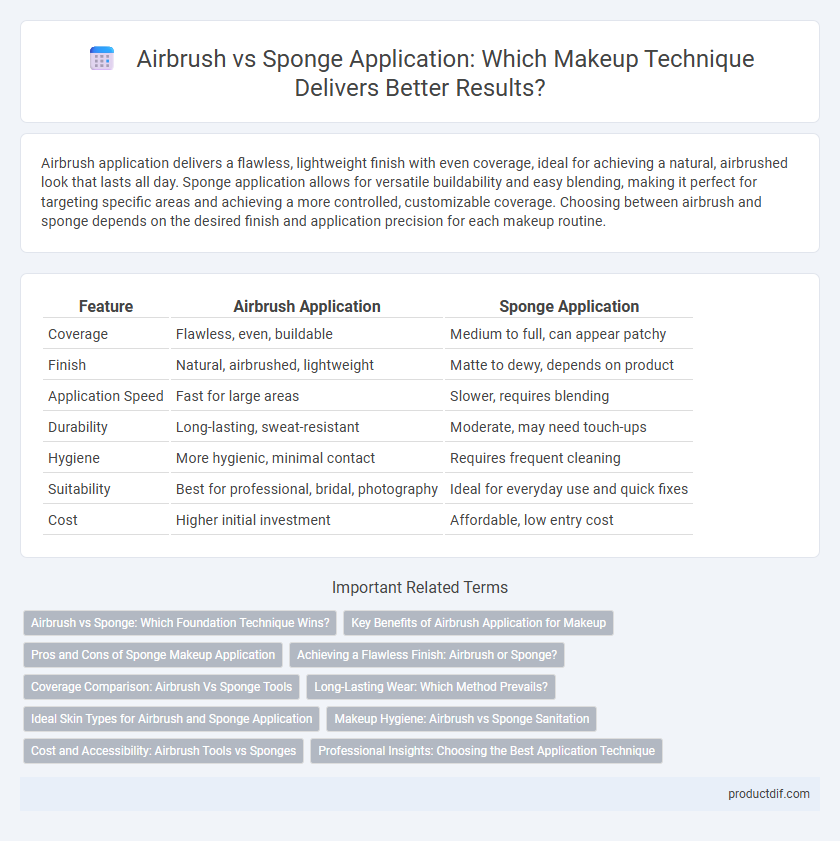Airbrush application delivers a flawless, lightweight finish with even coverage, ideal for achieving a natural, airbrushed look that lasts all day. Sponge application allows for versatile buildability and easy blending, making it perfect for targeting specific areas and achieving a more controlled, customizable coverage. Choosing between airbrush and sponge depends on the desired finish and application precision for each makeup routine.
Table of Comparison
| Feature | Airbrush Application | Sponge Application |
|---|---|---|
| Coverage | Flawless, even, buildable | Medium to full, can appear patchy |
| Finish | Natural, airbrushed, lightweight | Matte to dewy, depends on product |
| Application Speed | Fast for large areas | Slower, requires blending |
| Durability | Long-lasting, sweat-resistant | Moderate, may need touch-ups |
| Hygiene | More hygienic, minimal contact | Requires frequent cleaning |
| Suitability | Best for professional, bridal, photography | Ideal for everyday use and quick fixes |
| Cost | Higher initial investment | Affordable, low entry cost |
Airbrush vs Sponge: Which Foundation Technique Wins?
Airbrush application delivers a flawless, lightweight, and even finish by spraying a fine mist of foundation, making it ideal for high-definition photography and long-lasting wear. Sponge application offers precise control and buildable coverage, perfect for targeting specific areas and blending seamlessly with other makeup products. Both techniques cater to different skin types and desired outcomes, but airbrush stands out for its smooth, natural appearance and hygienic process.
Key Benefits of Airbrush Application for Makeup
Airbrush application delivers a flawless, lightweight finish with exceptional precision, ensuring even coverage and natural-looking skin. This technique offers superior longevity and resistance to smudging or fading compared to sponge application, making it ideal for long-lasting wear. Airbrush makeup is also more hygienic and reduces product waste by applying a fine mist rather than direct contact.
Pros and Cons of Sponge Makeup Application
Sponge makeup application offers seamless blending and natural finish, making it ideal for liquid and cream foundations. However, sponges can absorb more product, leading to potential waste and requiring frequent replacement to avoid bacterial buildup. While sponges provide better control in hard-to-reach areas, they may not achieve the same level of precision as airbrush techniques for ultra-fine coverage.
Achieving a Flawless Finish: Airbrush or Sponge?
Airbrush application delivers a lightweight, even layer of foundation that mimics natural skin texture, ideal for achieving a flawless, airbrushed finish with minimal streaking. Sponge application excels in blending and building coverage, allowing for a customizable finish that can range from sheer to full, but may require more touch-ups to maintain smoothness. For long-lasting, photo-ready results, professional makeup artists often prefer airbrush techniques, while sponges remain a versatile choice for everyday makeup routines.
Coverage Comparison: Airbrush Vs Sponge Tools
Airbrush application offers a lightweight, seamless finish with buildable coverage ideal for achieving a natural, flawless look, while sponge application provides more customizable coverage ranging from sheer to full by allowing controlled product layering. Airbrush tools deliver even, ultra-fine mist for smooth, poreless skin appearance, whereas sponges can sometimes result in patchiness depending on blending technique and product type. For makeup artists seeking precision and long-lasting wear, airbrush systems excel in coverage consistency, whereas sponges remain versatile for quick touch-ups and varying skin textures.
Long-Lasting Wear: Which Method Prevails?
Airbrush application delivers a finer, more even layer of foundation that bonds closely to the skin, resulting in longer-lasting wear compared to traditional sponge application. The lightweight, sheer finish of airbrush makeup resists smudging and fading throughout the day, making it ideal for events requiring extended durability. Sponge application, while effective for buildable coverage, tends to absorb more product and may require frequent touch-ups, reducing its longevity.
Ideal Skin Types for Airbrush and Sponge Application
Airbrush application is ideal for oily and combination skin types due to its lightweight, oil-free formula that provides a matte finish and long-lasting coverage. Sponge application works best for dry and sensitive skin because it allows for better absorption of moisturizing products and offers a more natural, dewy look. Understanding skin type helps in selecting the appropriate method to enhance foundation wearability and overall complexion.
Makeup Hygiene: Airbrush vs Sponge Sanitation
Airbrush application offers superior hygiene compared to sponge application due to its non-contact method, reducing the risk of bacterial contamination and skin irritation. Sponges, often prone to absorbing makeup and oils, require frequent and thorough cleaning to prevent buildup of bacteria that can cause breakouts and infections. Choosing airbrush makeup ensures a more sanitary experience, especially for sensitive or acne-prone skin types.
Cost and Accessibility: Airbrush Tools vs Sponges
Airbrush makeup systems typically entail a higher initial investment, with professional airbrush kits costing between $150 and $500, whereas makeup sponges are significantly more affordable, averaging $5 to $20 per pack. Airbrush tools require specific compressors and cleaning supplies, adding ongoing costs, while sponges are widely accessible, disposable, and require minimal maintenance. The accessibility of sponges in drugstores and online makes them a budget-friendly option for everyday users compared to the more specialized and costly airbrush setup.
Professional Insights: Choosing the Best Application Technique
Airbrush application delivers a flawless, lightweight finish ideal for high-definition photography and long-lasting wear, favored by professional makeup artists in bridal and editorial settings. Sponge application offers superior blendability and precision in contouring, making it the preferred choice for versatile, layered looks with a natural finish. Experts recommend selecting the technique based on skin type, desired coverage, and occasion to achieve optimal cosmetic results.
Airbrush Application vs Sponge Application Infographic

 productdif.com
productdif.com